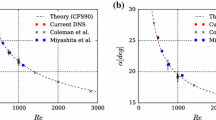Abstract
In Part I (1975), a linear stability analysis with respect to the formation of longitudinal vortex rolls was given for aturbulent boundary layer of the atmosphere. However, that analysis investigated the effect of inflection point instability only; therefore it is applicable only to the case of neutral stratification.
In Part II presented here, the analysis is extended to include the combined effect of inflection point instability and instability due to heating from below. In contrast with the result in Part I, the main result is that in considering both these effects, longitudinal vortex rolls can develop only if the boundary layer has an unstable stratification.
Another important result is that the structure of developing vortex rolls and their growth-rates are universal in a boundary layer with Rossby-number similarity, i.e., they are independent of any external parameter. The same is true for the orientation of the vortex rolls: the angle between the axis of the rolls and the surface stress is independent of external parameters. The only quantity which is not universal is the phase speed, which indicates the speed with which the rolls move in a direction perpendicular to the vortex axis; this phase speed depends on the geostrophic wind and on the roughness-length.
Similar content being viewed by others
Abbreviations
- a :
-
s H, the non-dimensional wave-number
- c :
-
complex phase speed in the periodic solutions
- c p :
-
specific heat at constant pressure
- C :
-
κc/u *
- C g :
-
u */|vg| (geostrophic drag coefficient)
- d :
-
characteristic depth of the Ekman layer, see Equation (2)
- f :
-
Coriolis parameter
- H :
-
κu */f (internal scale height of the PBL)
- K h :
-
k h /(H 2 f)
- K m :
-
k m /(H 2 f)
- k h :
-
turbulent diffusion coefficient for heat
- k m :
-
turbulent diffusion coefficient for momentum
- L * :
-
Obukhov stability length
- M m (μ):
-
universal function in the resistance law of a PBL
- N(μ):
-
universal function in the resistance law of a PBL
- n :
-
number of steps in the vertical
- PBL:
-
Planetary Boundary Layer
- P :
-
κ(ū − ū g )/u * (nondimensional components of the geostrophic departure)
- Q :
-
\(\left. {_{\kappa (\overline v - \overline v _g )/u_* }^{\kappa (\overline u - \overline u _g )/u_* } } \right\}\) (nondimensional components of the geostrophic departure)
- q :
-
vertical turbulent heat flux
- r :
-
k m,horiz/k m,vert
- Ra:
-
Rayleigh number, defined in Equation (11)
- Re:
-
Reynolds number, defined in Equation (2)
- Ri f :
-
Richardson flux number, defined in Equation (12)
- Ro0 :
-
surface Rossby number, defined in Equation (1)
- s :
-
wavenumber
- u, v, w :
-
velocity components
- u * :
-
friction velocity
- U :
-
κu/u *,V =κv/u *,W =κw/u * (nondimensional velocities)
- Z :
-
z/H
- z :
-
vertical coordinate
- z 0 :
-
roughness-length
- α 0 :
-
cross-isobar angle
- β :
-
g/\(\overline \vartheta \) (buoyancy factor)
- Λ :
-
γ/ϑ *
- γ :
-
complex amplitude of the periodic solution for ϕ′
- δ :
-
difference operator
- ε :
-
angle formed by the axis of the vortex rolls and the geostrophic wind
- ε*:
-
angle formed by the axis of the vortex rolls and the surface stress
- η :
-
transformed coordinate, see Equation (27)
- Θ:
-
ϑ/ϑ *
- ϑ :
-
potential temperature
- ϑ * :
-
characteristic temperature fluctuation
- κ :
-
von Karman’s constant
- λ :
-
complex amplitude of the periodic solution foru′ R
- Λ :
-
κλ/u *
- μ :
-
H/L * (internal stratification parameter)
- ρ :
-
density
- τ :
-
Reynold’s stress
- ϕ :
-
complex amplitude of the periodic solution forψ′ R
- Φ :
-
ϕ/(u 2 * f)
- ψ R :
-
stream-function in the (y R , z)-plane
- D :
-
at the levelz =z D , whereτ ≈ 0
- g :
-
geostrophic
- h :
-
for heat
- i :
-
imaginary
- m :
-
for momentum or for maximum
- R :
-
in a coordinate-system withx-axis along the vortex rolls
- r :
-
real
- T :
-
at the levelz =z T , at the top of the PBL
- 0:
-
at the levelz =z 0
- \((_{..}^ \sim )\) :
-
mean value for the PBL
References
Asai, T. and Nakasuji, I.: 1973, ‘On the Stability of Ekman Boundary Flow with Thermally Unstable Stratification’,J. Meteorol Soc. Japan 51, 29–42.
Businger, J. A., Wyngaard, J. C., Izumi, Y., and Bradley, E. F.: 1971, ‘Flux-Profile Relationships in the Atmospheric Surface Layer’,J. Atmospheric Sci. 28, 181–189.
Etling, D.: 1971, ‘Einfluβ der thermischen Schichtung auf die Stabilität einer Ekman’schen Grenzschichtströmung’,Beitr. Phys. Atm. 44, 168–186.
Etling, D. and Wippermann, F. K.: 1975, ‘On the Instability of a Planetary Boundary Layer with Rossby Number Similarity’,Boundary Layer Meteorol. 9, 341–360.
Kurz, H.: 1976, ‘Turbulente Diffusion in einer Grenzschicht mit Rossby-Zahl Ähnlichkeit’, Dissert. Inst. f. Meteorologie, Techn. Hochschule Darmstadt, December 1976, 66 pp.
Wippermann, F.: 1973, ‘The Planetary Boundary Layer of the Atmosphere’, Vol. 7 ofAnnalen der Meteorologie, pp. X + 346, Deutscher Wetterdienst, Offenbach/M., F.R.G.
Wippermann, F. K.: 1975, ‘Properties of the Thermal Boundary Layer of the Atmosphere - Obtained with a PBL-Model’,Beitr. Phys. Atm. 48, 30–45.
Author information
Authors and Affiliations
Rights and permissions
About this article
Cite this article
Wippermann, F.K., Etling, D. & Kirstein, H.J. On the instability of a planetary boundary layer with Rossby number similarity. Boundary-Layer Meteorol 15, 301–321 (1978). https://doi.org/10.1007/BF02652603
Received:
Published:
Issue Date:
DOI: https://doi.org/10.1007/BF02652603




